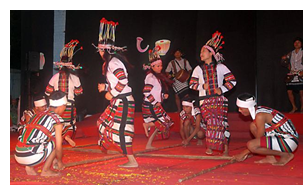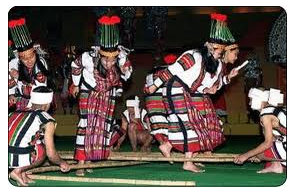DANCE FORMS OF MIZORAM
Contents
· Introduction
· Cheraw or Bamboo dance
· Khal Lam
· Chaithe
· Sawlakia
· Chhilam
· Zu Party
· Music Gatherings
· Musical Instruments
Introduction
Mizoram, a state located in the north-eastern part of India, is a very colourful and culturally rich state. The Mizos are a fun-loving people and they love their art and culture. The most important Mizo dances are briefly described as follows:
Cheraw or Bamboo dance
It is the most popular of all the Mizo dances. Also prevalent in some parts of Philippines, Cheraw is performed by a group of twelve girls. Six of them, wearing very colourful costumes, squat on the ground holding bamboo poles, which are rhythmically shifted and struck against one another. The other group of six girls shifts between the moving bamboos.
Khal Lam
It is another very popular dance from of the Mizos. The performance involves stepping forward and backward in a rhythmical and systematic manner. The arms are also flayed along with the alternating steps. The dancers wear Puan or striped loincloth and Puandum or uniformly striped shawls.
Chaithe
Performed on the occasion of the Chapchar Kut festival, Chaithe dance is performed throughout the night by the participating boys and girls. The boys sit with their backs towards the walls and the girls would sit between the knees of the boys. The pair of boys and girls would sit in a circular pattern. In the open courtyard in front of them, both girls and boys perform dances of any form. The drummer is positioned at the centre of the circle and another person is entrusted with the job of singing and chanting. The dance performance is alternated with chants of Zu by the surrounding audience.
Sawlakia
Meaning the spirit of the slain, Sawlakia is an extremely popular dance among the Mizos. The Sawlakia was originally a Lakher dance, but has been steadily adopted by the Mizos. The dance is performed after hunting of a big game or killing an enemy. The main dancer sports his best dress and wears a plume of red feather. He wields a dao or a gun in his hands. A group of boys keeps on beating the drums and follows the lead dancer. They move in a circular direction, around the slain head. The women audiences keep on chanting Zu along with the performance.
Chhilam
This form of dance was earlier performed in Beer parties. However, the modern adaptation of the dance form has a much moderated and subdued outlook. It is usually performed by elderly men and women, who sit in a circular pattern, with the drummer at the centre of the circle. Anecdotes and songs are exchanged by the participants, each taking his turn to perform the dance at the centre.
Zu Party
It is an occasion for singing and dancing, and the songs are usually slow and mournful in nature. Drums, gongs and cymbals usually accompany the song. The themes are generally episodes of love, traditional heroic feats, eulogy or hunting episodes etc. Usually a single singer starts the song and later it is followed by the entire group.
Music Gatherings
In a majority of the Mizo villages, groups of young men and women gather in the evening to sing, dance and make merry in the evening. Spanish guitars are the most popular musical instrument among the Mizo youth. Recently, the trend is tilting towards the ultra-modern pop music.
Musical Instruments
The most popular musical instruments of the Mizos, to accompany the song and dance occasions are briefly described as follows:
- Drums (made from hollowed tree trunks and dried hides)
- Gongs (are made of brass and comes in various sizes)
- Flutes (are made from selected pieces of bamboo)
- A special kind of instrument made from hollowed out gourd, with hollow reeds inserted


